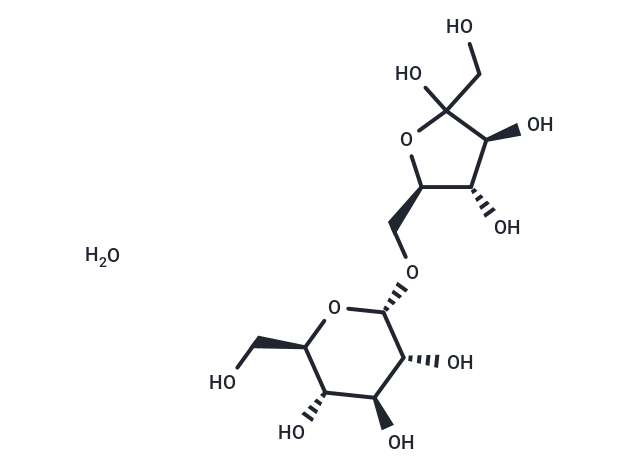Shopping Cart
- Remove All
 Your shopping cart is currently empty
Your shopping cart is currently empty

Palatinose hydrate (6-O-α-D-Glucopyranosyl-D-fructose, Isoma) is a disaccharide having an α(1→6) linkage between D-glucose and D-fructose and is similar to sucrose in its physicochemical properties. It is produced from sucrose in some bacteria by the action of sucrose isomerase. In mammalian gut, palatinose is hydrolyzed and absorbed much more slowly than sucrose.

| Pack Size | Price | Availability | Quantity |
|---|---|---|---|
| 5 g | $52 | In Stock | |
| 1 mL x 10 mM (in DMSO) | $29 | In Stock |
| Description | Palatinose hydrate (6-O-α-D-Glucopyranosyl-D-fructose, Isoma) is a disaccharide having an α(1→6) linkage between D-glucose and D-fructose and is similar to sucrose in its physicochemical properties. It is produced from sucrose in some bacteria by the action of sucrose isomerase. In mammalian gut, palatinose is hydrolyzed and absorbed much more slowly than sucrose. |
| Alias | 6-O-α-D-Glucopyranosyl-D-fructose, Isoma |
| Molecular Weight | 360.31 |
| Formula | C12H24O12 |
| Cas No. | 343336-76-5 |
| Smiles | O.OC[C@H]1O[C@H](OC[C@H]2OC(O)(CO)[C@@H](O)[C@@H]2O)[C@H](O)[C@@H](O)[C@@H]1O |
| Relative Density. | 1.77g/cm3 |
| Storage | Powder: -20°C for 3 years | In solvent: -80°C for 1 year | Shipping with blue ice. | ||||||||||||||||||||||||||||||
| Solubility Information | DMSO: 22.5 mg/mL (62.45 mM), Sonication is recommended. | ||||||||||||||||||||||||||||||
Solution Preparation Table | |||||||||||||||||||||||||||||||
DMSO
| |||||||||||||||||||||||||||||||

Copyright © 2015-2025 TargetMol Chemicals Inc. All Rights Reserved.